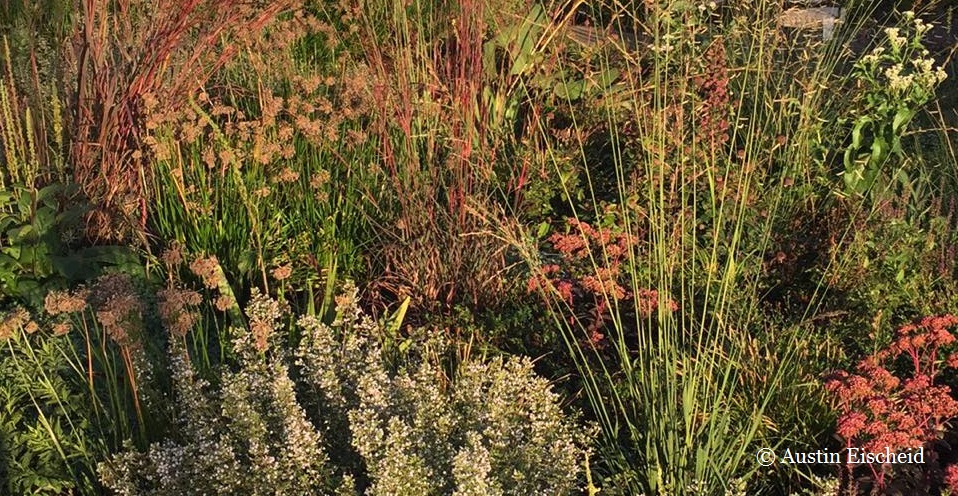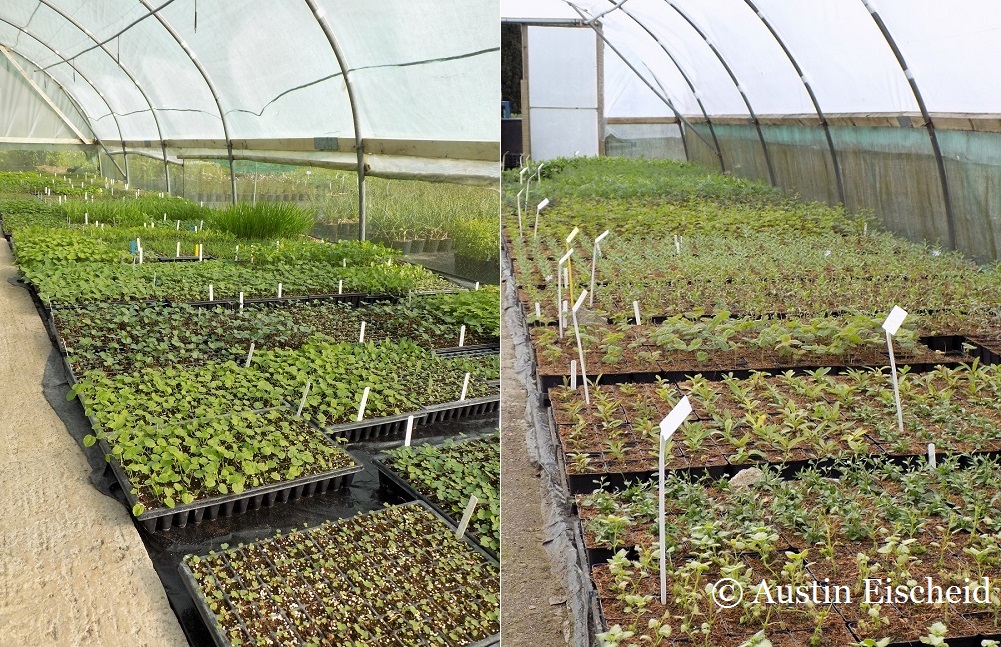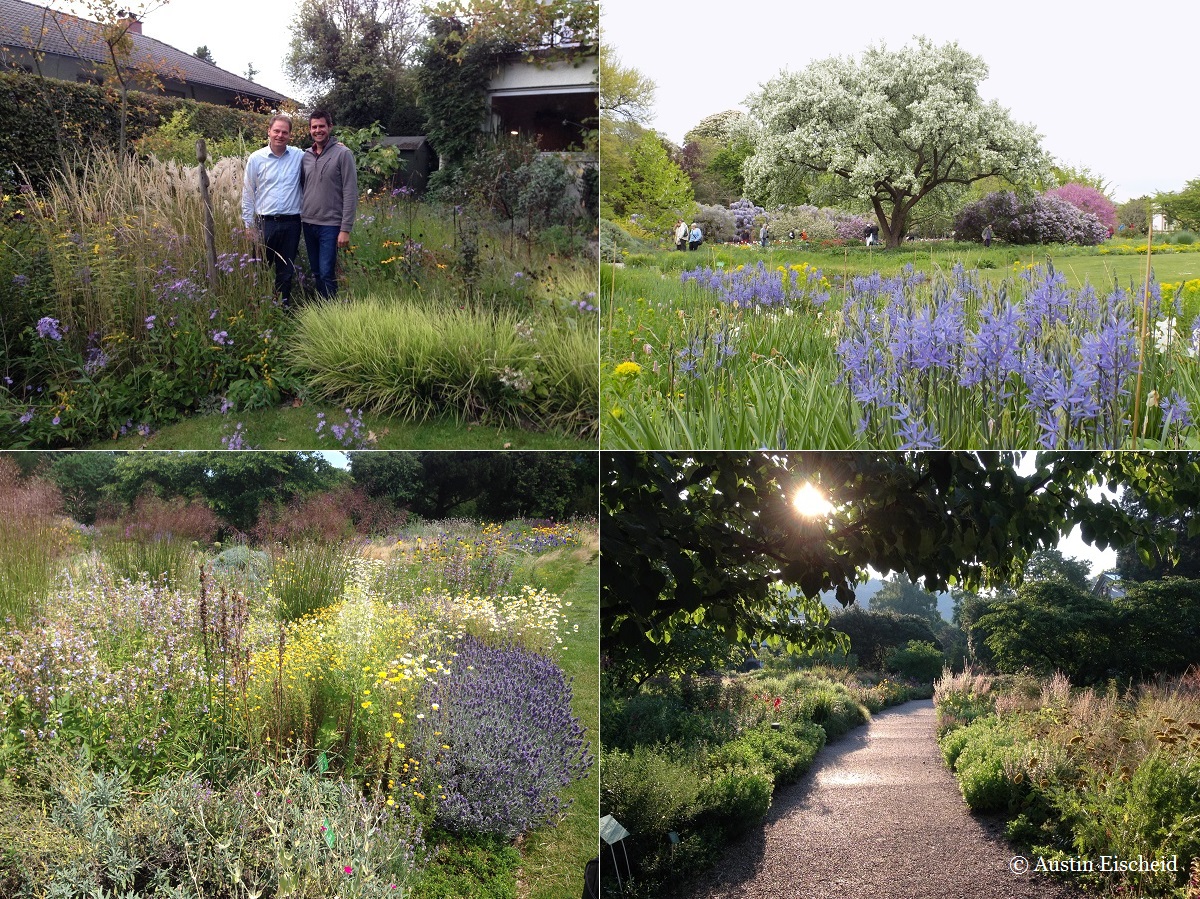5-10-5: Austin Eischeid, Garden Designer
Through the gardening network, Austin and I were introduced online where we bonded over plants and garden design. When he visited the Delaware Valley region for gardens and nurseries, we had a fun time evaluating plantings at Chanticleer, and comparing notes over plants at the North Creek Nurseries trial beds. Austin is now pursuing his degree iin landscape architecture at University of Greenwich in London, United Kingdom, and the program should round out his strong experiences here in North America and overseas.
Please introduce yourself.
I’m Austin Eischeid, a garden designer currently based in London to learn, get inspiration and meet professionals with the same passion for plants.
The arts or horticulture?
I don’t think one could exist without the other.
It seems that your interest in gardening developed early as you seem advanced on the basis of your knowledge and experiences. What is your professional and educational background?
I was first brought into this fascinating world of horticulture when my parents let my sister and I experiment with a vegetable garden at the age of 4. It was so fascinating to see these flowers develop into the vegetables we eat everyday. My mother has a lot to do with my passion of plants. She’s the one who taught me confidence, not being afraid to fail and that the sky is the limit.
After vegetables I turned to roses and perennials. I started a rose garden then found out how high maintenance they can be, then converted it over to a sedum garden, talk about a transition. After this I started in my early teens adding different perennials such as: daisies, blood grass, cat mint and tickseed coreopsis to the mix. It progressively grew every year after that. There isn’t a better education on plants then growing them yourself and seeing their life cycle, habit, and seasonal beauty.
I knew from freshman year in high school that I wanted to get my BS at Iowa State University in Horticulture. I graduated in 2011 from ISU in Horticulture with an emphasis in Landscape Design, Installation and Management. I started my professional experience in residential perennial garden maintenance.
Lately I’ve been traveling Europe for inspiration and educating myself on the perennial movement. My first year (12’) I bought a one way ticket to London and traveled from nursery to garden center to botanical garden, looking for direction. Which let me to these past three years I’ve had three month internships at: Pomosus Landscaping in Dresden, Germany, Hermannshof in Weinheim, Germany and Orchard Dene in Henley-on-Thames, England.
At what point did you decide that garden design was your future direction after being a floral designer and horticulturist?
I’ve known since early high school that I wanted to be a garden designer. My hometown in Iowa of 10,000 and surrounding area are lacking curb appeal. I wanted to bring horticulture into our culture and show people they can have a space to relax, reflect and enjoy at their own home. I feel people have been misguided/ disappointed after trying the thug perennials offered at big box stores and feel they are the ones doing something wrong. People need access and education on hardy/strong perennials that are for their specific region, water, light, and soil requirements.
Russell Page once wrote: "in the town as in the country, a wise garden designer will study his site in silence and consider carefully his clients, their taste, their wishes, their way of life, their likes and dislikes, and absorb all of these factors at least as important as the ground that lies in front of him." Garden design is similar to psychology where you discern your client's personal taste and align it with your vision. How do you navigate that tightrope between compromise and confidence in your style?
I embrace my client’s differences and try to make their design special to them. If they have an issue with, say the color purple, which is very important in my design. It’s a matter of educating your client why you use it and how it will affect the design. Sometimes you have to remind your client why they hired you, a professional to do their design.
Sometimes designed gardens can be strangely impersonal especially if the owners are more interested in them as displays of wealth and status. Imagine if a Russian oligarch commissioned you to design his country estate outside of London but is more of an absentee owner who visits the garden twice a year, would you consider the job for financial gain and be willing to accept last minute changes?
It would depend on if the client and I had good chemistry. I like my clients to have curiosity and willingness to learn about their garden. If your client doesn’t care then the garden will never evolve. I wouldn’t do it for financial gain, but if I knew the space would be properly maintained and would benefit from my design style, why not.
During your initial site visit, what do you evaluate first? Soil? Hydrology? Or light?
All three are essential, but I would say soil is most important. If you don’t evaluate the soil you’re working with then your doomed from the beginning. Sometimes we forget that half of the plant is growing underground.
Designing a garden is one endeavor but to find someone or team competent enough to maintain the garden over time is another one. What kind of involvement do you anticipate after the design has been fulfilled and at what point will the garden evolve without your input?
I’m very much apart of my clients garden’s long term. I educate my clients and set them up with all the necessary tools they need to keep the gardens integrity. But I know you can’t throw all this information to them and expect them to take care of the garden from the moment you leave. Since I’m not around to check on or personally maintain the designs I’ve done I send my clients emails periodically. Sending emails during important times in the garden season, like when to do the Spring cleaning chop or a friendly reminder to weed until the plants have filled in.
Chelsea Flower Show has been criticized for its heavy reliance on show gardens and overlooking the Floral Marquee where the real stars are the plants. How do you feel about the gulf between the plants people and the designers? The expectations foisted on plants people to produce unseasonal plants in peak form for the show gardens can be stressful, yet the media attention is focused on the challenges garden designers face in realizing their plans to fruition before judging.
The media makes the show gardens the top priority, but when you’re in the hustle and bustle that is Chelsea I think everyone shines at their particular sector of the industry. There’s no doubt how special and unique the show is and how much it influences/inspires the industry worldwide.
I actually heard a lot of talk about using seasonal plants this year, but mostly pertaining to the repetition of similar plant material in all gardens. I don’t know how much of the plant material is forced too much out of season, because I heard a lot of talk about what it would be like to have Chelsea perhaps in the Fall or late Summer? It seems as though many gardens plant choices over lap and so you tend to see some trends repeated year after year. This years popular grasses were Luzula nivea, Melica altissima ‘alba’, Deschampsia cespitosa, and Briza media. These grasses are used because their early bloomers, but what if they could use all the great Miscanthus, Panicum, and Pennisetum?
Landscape architecture is often depicted as a profession where the plants are secondary to hardscaping. One well-known horticulturist was dismissive of landscape architects, saying that drawing bubbles and circles in place of plants was not real gardening and did not respect the plants' specific requirements. You are about to enroll in the landscape architecture masters program at Greenwich, and the tangible connection to plants may be lost. What mindset will you adopt during the program?
I am at University of Greenwich to enrich my technical background (AutoCAD and 3-D modeling), drafting and to learn how to use space. Studying in London I’m going to be surrounded with undeniably some of the best parks, landscape, and gardening culture. My passion for plants will be enhanced from my curiosity and living in such a green community.
The Marchants' wholesale nursery Orchard Dene, where you spent last spring (2015) working, is the chief supplier for garden designers seeking grasses and herbaceous perennials that govern the current look. How has your time there influenced and broadened your planting perspective?
Spending time at Orchard Dene Nursery this spring was a great experience, as I wanted to see first hand the plant process it takes from seed to job site. While at Orchard Dene I was doing a lot of propagation (pricking out, cuttings and divisions) and potting. Having worked at an impeccable nursery growing quality plant material in peat-free compost, it was an excellent place to see how a nursery should be ran. I was lucky to be immersed in a nursery with such an array of hardy long-lived perennials to choose.
Orchard Dene primarily sells to designers such as: Dan Pearson, Tom Stuart Smith, Marcus Barnett and Cleve West. It was exciting to go through their pulled plant orders to get a glimpse of some of the combinations they were putting together in their designs. Working intimately with plants whether it is in your own garden or working with them in a nursery helps you understand better their characteristics and environmental needs.
You are a veteran of European gardens after visiting them in Belgium, Germany, Netherlands, and England. What differences have you perceived among the gardens in those countries? There will be obvious overlaps in plants and styles, but each culture views their gardens differently.
In the Netherlands I found that the Dutch are very possessive of their land. They put hedges around their property border to show that it’s theirs and they love clean lines, very linear. England has a very high maintenance regime and spends more time in the garden than sitting to enjoy it. For example: rose training/trimming, intense vegetable gardens, and espalier. Germans have a very practical /scientific approach to gardening. They do their research and make sure their plantings are well thought out.
One forte of English gardens is their layering of woody plants with bulbs and herbaceous perennials. For instance, Beth Chatto's woodland garden is an outstanding example of a celebrated virtuoso orchestrating understory shrubs, bulbs, and shade perennials. Shrubs are not always regulated to hedges or topiary, but become key features in mixed borders. You had mentioned that your knowledge of shrubs is still in its infancy, but expect it to change. Are you of the Dutch and Belgian mentality of having woody plants sheared into tight frameworks or you prefer the natural forms, like the apple orchard with its meadow?
I don’t use a lot of shrubs in my current foundation residential design work, but would like to on larger scale projects. I think hedged and natural shrub forms are both useful in design. Since my style is very naturalistic and free flowing, using a sheared hedge behind a naturalistic planting just makes things feel harmonious. I also would use shrubs for their natural form when I place them within a design, just depends on the specific feeling of the space.
What influential people or individuals have you been inspired by?
I was first inspired to using hardy, long-lived perennials when I saw Roy Diblik speak in 2008 at Iowa State University’s Shade Tree Short Coarse my freshman year. His discussion about The “Know” Maintenance Garden changed my whole outlook on gardening. He became one of my mentors alongside Piet Oudolf, Cassian Schmidt and Adam Woodruff. You cannot underestimate the power of a good mentor, people in the horticulture industry are so willing to share the knowledge they’ve collected over the years. You just have to ask!
Name and describe some of your favorite plants.
Calamintha nepeta subsp. nepeta
This plant is a great buffer/groundcover plant that can intermingle with almost any plant. Its petite foliage are a glossy bright green, which comes up as almost a ball form. But when it starts to bloom it has a more open habit. It has thousands of these miniature soft blue, but white to the eye bell shaped flowers that seem to hold on forever. Calamintha blooms from mid summer till frost, then leaves turn a deep purple in autumn.
Bouteloua gracilis ‘Blonde Ambition’ - I can’t seem to take my eye off this grass. It gets hundreds of magical one-inch caterpillar-like seed heads that dangle horizontally, in which seems like midair. This drought tolerant grass gets 3’x2’ and keeps its structure through the winter.
Allium ‘Summer Beauty’- This well-rounded perennial can grow in full sun to part shade. Not only is this plant drought tolerant but, almost loves complete neglect. I can’t help but love this plant in every season. Its vivacious, shiny green seaweed-like foliage all summer long and it’s over 150 golf ball sized lavender blooms dangling above the foliage. This plant holds up to it’s name ‘Summer Beauty.’ Not to mention a bee and butterflies best friend. Plant turns a liquid gold color in the autumn with the spent blooms looking perky all winter long.
Your desert island plant?
Monarda bradburiana- This plant just has it all. Its mildew-free foliage in spring starts out a luscious burgundy, then has a gorgeous soft pink flower with fuchsia dots on each petal, pink bracts and a sweet smell. Its pinhead cushion seed heads might even top the flower by turning rosy pink after blooming. In autumn the foliage turns back to a rich burgundy-red. If that isn’t enough you can also make tea out of the foliage.
 Germinating the seed of interest in plants for young kids who are increasingly immersed in a virtual world isn't easy - you obviously had some young visitors to your Iowan garden. How did their reactions differ from adults who are already avid gardeners?
Germinating the seed of interest in plants for young kids who are increasingly immersed in a virtual world isn't easy - you obviously had some young visitors to your Iowan garden. How did their reactions differ from adults who are already avid gardeners?What advice do you wish to give to those keen on a profession as a garden designer?
You're lucky to have found a career where you can make people happy by giving them an oasis and surround yourself by passionate people who love what they do. Get to know your plants, the best way is through growing them yourself; don’t be afraid to get your hands dirty. Take advantage of networking with as many professionals in the industry as possible, because the great thing about horticulturist is most people are willing to share their knowledge to better the profession. Get a good mentor you look up to that will set you in the right path.
What do you look forward to?
I’m looking forward to exploring more natural plant habitats around the world and seeing how plants are growing in their natural homes.
Thank you Austin for your interview! ~ Eric

















